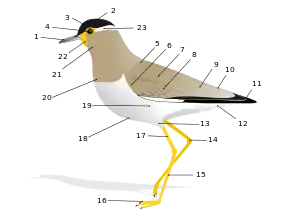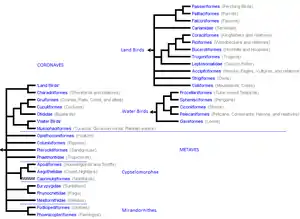Outline of birds
The following outline is provided as an overview of and topical guide to birds:

House sparrow, Passer domesticus
Birds (class Aves) – winged, bipedal, endothermic (warm-blooded), egg-laying, vertebrate animals. There are around 10,000 living species, making them the most varied of tetrapod vertebrates. They inhabit ecosystems across the globe, from the Arctic, to the Antarctic. Extant birds range in size from the 5 cm (2 in) bee hummingbird to the 2.75 m (9 ft) ostrich.
What type of thing is a bird
A bird can be described as all of the following:
- Life form – entity or being that is living or alive.
- Animal – multicellular, eukaryotic organisms of the kingdom Animalia (also called Metazoa). Their body plan eventually becomes fixed as they develop, although some undergo a process of metamorphosis later on in their lives. Most animals are motile, meaning they can move spontaneously and independently.
Nature of birds
Bird anatomy

External anatomy (topography) of a typical bird: 1 Beak, 2 Head, 3 Iris, 4 Pupil, 5 Mantle, 6 Lesser coverts, 7 Scapulars, 8 Coverts, 9 Tertials, 10 Rump, 11 Primaries, 12 Vent, 13 Thigh, 14 Tibio-tarsal articulation, 15 Tarsus, 16 Feet, 17 Tibia, 18 Belly, 19 Flanks, 20 Breast, 21 Throat, 22 Wattle, 23 Eyestripe
Bird behavior
Bird behavior
Types of birds
Orders
Families
Subfamilies
Genera
History of birds
Study of birds
Aviculture
Bird diseases and parasites
Threats and conservation
- Avicide
- Bird conservation
- Bird sanctuary
- Bird conservation groups
- Important bird areas
- Bird control
- Bird strike
- Towerkill
Persons influential in the field of birds
Artists
Ornithologists
Writers
Birds in culture
See also
References
External links
- Ornithology course outline, Alabama School of Math and Science
This article is issued from Wikipedia. The text is licensed under Creative Commons - Attribution - Sharealike. Additional terms may apply for the media files.
